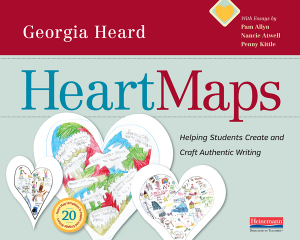
The following essay by Penny Kittle appears in Georgia Heard’s newest book, Heart Maps: Helping Students Create and Craft Authentic Writing.
Tune in to Your Heart Map Playlist
By Penny Kittle
Music unlocks memories.
Pachelbel’s Canon in D Major puts me at the back of a church on a snowy December Saturday, trembling as I hold my father’s hand. He pats my arm and says, “Easy now,” as we start toward the altar.
When a song I once labored to learn on my guitar comes on the radio it transports me to Oregon State’s campus, and I see a swirl of fall color as I walk from class with my black guitar case bumping my leg in a bouncing rhythm. I’m twenty again and the year suddenly returns to me in images, feelings, and songs.
Our hearts hold hidden playlists.
When I create heart map playlists with students, they access moments that might become poems or memoirs or even the anchors to essays they didn’t realize were inside of them, waiting to be written.
A heart’s playlist is more than a list of titles. We sort them as we freely find and list bits of lyrics. At the center are the songs most precious to us and on the outside edge are the ones we once loved but have grown tired of. Some students have listed tunes they wished they could forget outside of their hearts—like those advertising jingles that stubbornly repeat and annoy. Amelya split the heart in half and listed songs and concerts she has shared with her dad on one side and the songs her mom sings while cooking on the other.
Once we’ve listed for several minutes I have students select one song to quickly write about—to make it the soundtrack to a story they want to relive line upon line. And yes, they can put headphones on and write with the song playing to deepen their remembering, as I often do myself. Some students adopt headphones as a regular part of their writing routine in class, allowing music to help them block out distractions and draft more easily. I know this move as a writer: I’ve created a playlist for every book I’ve written. The familiarity of notes relaxes me and I sink into words.
The music heart map led Joe back to fishing with his father. He filled his notebook with pages of memories, finding that the words themselves led him to the details of a time long past. This was a turning point for his engagement in my class, in the hard work of writing, and in the satisfaction of finding something he wanted to say well as he labored over revision and rethinking. And music led Hannah to a forgotten innocence—her twelve-year-old self belted in the backseat next to her best friend, singing along to music from the Broadway show Wicked. The friendship had ended, but the bitterness of that was suddenly replaced by memories of that friendship’s value in her life.
My students and I discover the gift of a heart map playlist: to soothe, to comfort, to remind us of the beauty in our past and in our daily living.
♦ ♦ ♦
Want to give heart mapping a try today? Download a sample from Heart Maps that includes a sample heart map template: “Be the Change That You Wish to See in the World”
 In Heart Maps, beloved author Georgia Heard (@GeorgiaHeard1) shares 20 unique, multi-genre heart map templates to help students write more…and more authentically. Supported with writing ideas, suggested mentor texts, and tips for getting started with heart mapping, Heart Maps is a practical resource for every teacher.
In Heart Maps, beloved author Georgia Heard (@GeorgiaHeard1) shares 20 unique, multi-genre heart map templates to help students write more…and more authentically. Supported with writing ideas, suggested mentor texts, and tips for getting started with heart mapping, Heart Maps is a practical resource for every teacher.


